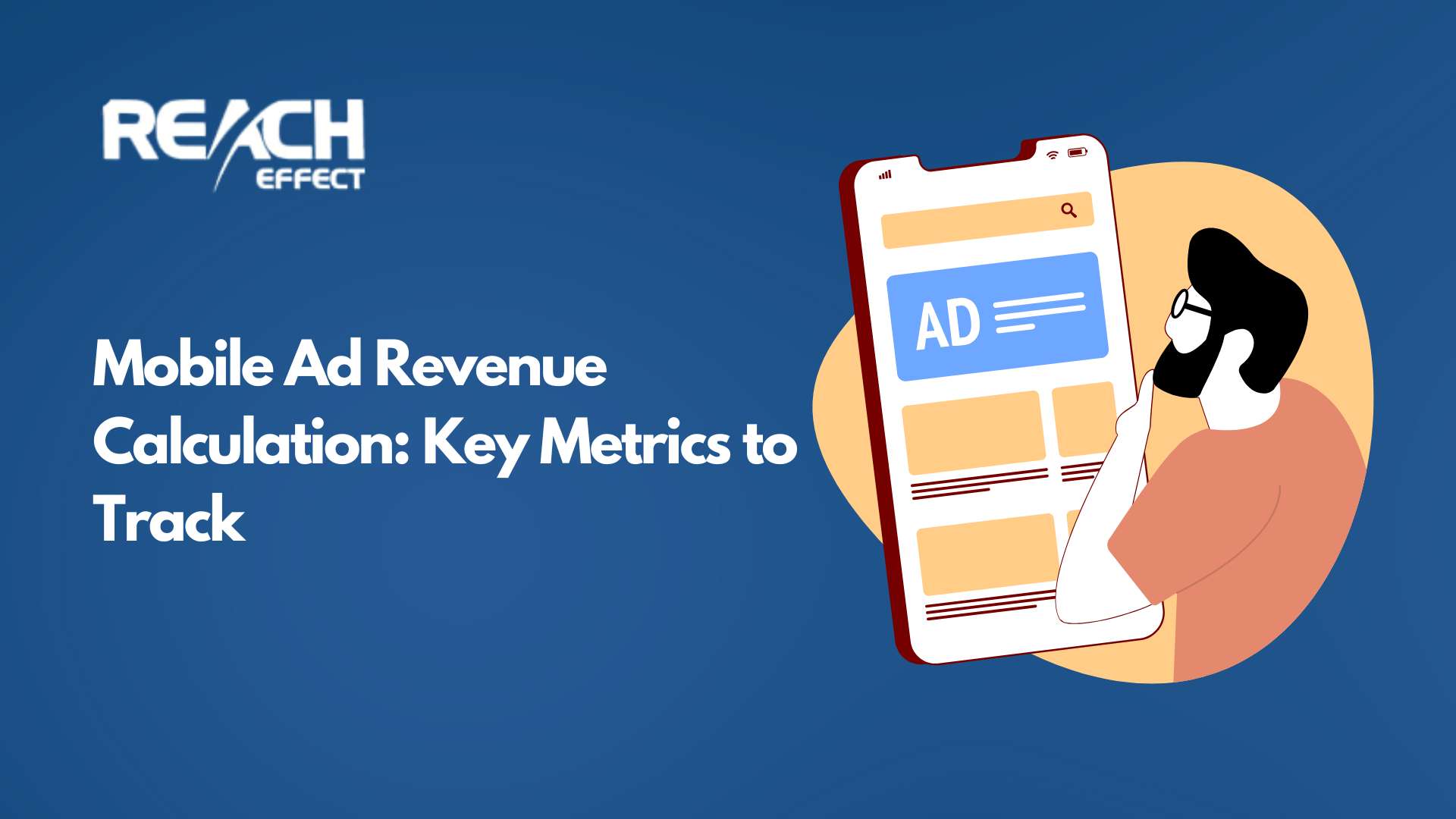Hey, fellow app developer! If you’re here, I’m guessing you want to figure out how to make more money from your mobile app through ads. Maybe you’ve got some ads running already, but the numbers aren’t adding up the way you’d hoped. Or perhaps you’re new to this and just want to get a handle on how it all works. Either way, I’ve got your back! Let’s dive into the world of mobile ad revenue together and break it down into bite-sized, easy-to-digest pieces.
In this guide, we’ll explore how to calculate mobile ad revenue, unpack the key metrics you need to track, and share some practical tips to help you maximize your mobile app advertising revenue. I’ll keep things friendly and straightforward. Let’s get started!
Why Mobile Ad Revenue Matters (And Why You Should Care)
Picture this: you’ve poured your heart into building an awesome app, and now it’s time to see some cash flow. For many of us, ads are a fantastic way to generate income, especially if your app is free to download. Mobile app advertising revenue is the money you earn when users see or interact with ads in your app. Think banner ads, video ads, or those full-screen pop-ups between game levels.
But here’s the catch: to really make the most of it, you’ve got to understand the numbers behind it. That’s where calculating your revenue comes in. It’s not just about throwing ads into your app and hoping for the best. It’s about knowing what’s working, what’s not, and how to tweak things to boost your profits. Let’s start with the basics.
Understanding Key Mobile Advertising Metrics
Before we jump into formulas, we need to get comfy with the metrics that drive mobile ad revenue. These are the building blocks that’ll help you figure out how much you’re earning and where you can improve. Don’t worry—I’ll explain each one like I’m chatting with you over coffee.
Cost Per Mille (CPM): Your Earnings Per Thousand Views
What is CPM? CPM stands for “cost per mille” (fancy Latin for “thousand”). It’s the amount an advertiser pays—or you earn—for every 1,000 times an ad is shown in your app. An “impression” is just a fancy way of saying someone saw the ad, whether they clicked it or not.
How to calculate CPM: Take the total cost of the ad and divide it by the number of impressions (in thousands). For example, if an ad costs $20 and gets 10,000 impressions, the CPM is $2 ($20 ÷ 10 = $2 per thousand).
Why it matters: CPM is a big deal because it tells you how much you’re raking in every time your app serves up a thousand ad views. Want a higher CPM? Apps with engaged users or premium content often snag better rates… Something to keep in mind as you grow.
Cost Per Click (CPC): Paying for Action
What is CPC? CPC means “cost per click.” It’s how much an advertiser shells out every time someone clicks their ad. Simple, right?
How to calculate CPC: Divide the total ad cost by the number of clicks. Say an ad costs $50 and gets 100 clicks—that’s a CPC of $0.50 ($50 ÷ 100).
Why it matters: For advertisers, CPC shows how much they’re paying to get folks to their site or app. For you, it’s a clue about how engaging your ads are. If you’re using CPC-based ads, higher clicks can mean more revenue. Pretty cool, huh?
Click-Through Rate (CTR): Are Your Ads Clicking with Users?
What is CTR? CTR, or “click-through rate,” tells you how often people click an ad after seeing it. It’s a percentage that shows how appealing your ads are.
How to calculate CTR: Divide the number of clicks by the number of impressions, then multiply by 100. For instance, if an ad gets 50 clicks out of 2,000 impressions, the CTR is 2.5% (50 ÷ 2,000 × 100).
Why it matters: A high CTR is like a gold star. It means your ads are hitting the mark with your audience. Better relevance (think ads that match your users’ interests) can lift your CTR and, in turn, your earnings.
Effective Cost Per Mille (eCPM): The Real Revenue Picture
What is eCPM? eCPM stands for “effective cost per mille.” It’s like CPM’s cooler cousin because it shows what you’re actually earning per thousand impressions, factoring in things like fill rate.
How to calculate eCPM: Divide your total ad revenue by the number of impressions (in thousands). If you made $300 from 75,000 impressions, your eCPM is $4 ($300 ÷ 75).
Why it matters: eCPM is your go-to metric for comparing revenue across ad networks or formats. Want to bump it up? Try testing different ad placements or swapping in new formats to see what clicks with your users.
Fill Rate: Filling the Revenue Gaps
What is fill rate? Fill rate is the percentage of ad requests that actually get filled with an ad. If your app asks for an ad but doesn’t get one, you’re leaving money on the table.
How to calculate fill rate: Divide the number of impressions by the number of ad requests, then multiply by 100. If you request 1,000 ads and get 900 impressions, your fill rate is 90%.
Why it matters: A low fill rate is a revenue killer. To fix it, consider mediation—using multiple ad networks to ensure more requests get filled. It’s like having a backup plan for your backup plan!
Average Revenue Per User (ARPU): Cash Per User
What is ARPU? ARPU, or “average revenue per user,” shows how much money each user brings in on average. It’s a snapshot of your monetization success.
How to calculate ARPU: Divide your total revenue by the number of users. If you earned $1,500 from 1,000 users, your ARPU is $1.50.
Why it matters: ARPU helps you see how well you’re turning users into dollars. If it’s low, it might be time to tweak your ad strategy or add other revenue streams like in-app purchases.
How to Calculate Mobile Ad Revenue: Let’s Crunch Some Numbers
Alright, now that we’ve got the metrics down, let’s put them to work. Calculating your mobile ad revenue isn’t rocket science. It’s just a matter of plugging the right numbers into some simple formulas. I’ll walk you through it with examples so you can see it in action.
Basic Ad Revenue Calculation: The Starter Formula
Here’s the simplest way to figure out your revenue:
Revenue = (Impressions ÷ 1,000) × CPM × Fill Rate
- Impressions: How many times your ads were shown.
- CPM: Your earnings per thousand impressions.
- Fill Rate: The percentage of ad requests that got filled.
Example Time: Let’s say your app racked up 2,000,000 impressions, your CPM is $6, and your fill rate is 85%.
- Step 1: Convert impressions to thousands: 2,000,000 ÷ 1,000 = 2,000.
- Step 2: Multiply by CPM: 2,000 × $6 = $12,000.
- Step 3: Adjust for fill rate: $12,000 × 0.85 = $10,200.
Boom! Your revenue is $10,200. Easy, right?
Calculating Revenue with Multiple Ad Networks: Mixing It Up
Lots of apps use more than one ad network to keep the cash flowing. When that’s the case, you calculate revenue for each network and then add them up.
Total Revenue = Revenue from Network A + Revenue from Network B + …
For each network, use:
Revenue = (Impressions ÷ 1,000) × eCPM × Fill Rate
Example Time: You’ve got two networks:
- Network A: 800,000 impressions, eCPM of $5, fill rate of 90%.
- (800,000 ÷ 1,000) × $5 × 0.90 = 800 × $5 × 0.90 = $3,600.
- Network B: 600,000 impressions, eCPM of $7, fill rate of 75%.
- (600,000 ÷ 1,000) × $7 × 0.75 = 600 × $7 × 0.75 = $3,150.
- Total Revenue: $3,600 + $3,150 = $6,750.
See? Just a little math, and you’ve got your total earnings.
Projecting Future Ad Revenue: Looking Ahead
Want to guess what’s coming down the pipeline? You can project future revenue using your current numbers and a growth rate.
Future Revenue = Current Revenue × (1 + Growth Rate)
Example Time: Your current revenue is $8,000, and your user base is growing at 15% per month.
- $8,000 × (1 + 0.15) = $8,000 × 1.15 = $9,200.
So, next month, you could be looking at $9,200. Just keep in mind this is an estimate—things like ad rates or user habits can shake things up.
Tools to Make Tracking a Breeze
Manually crunching these numbers every day? No thanks! Luckily, there are tools to help you track your mobile ad revenue like a pro. Here’s what’s out there:
Mobile Measurement Partners (MMPs): Your Analytics Sidekick
MMPs are like your personal data wizards. They track ad performance, show you where your revenue’s coming from, and help you optimize. Some top picks:
- Adjust: Great for attribution and user-friendly dashboards.
- AppsFlyer: Awesome analytics with fraud protection built in.
- Branch: Perfect if you’re into deep linking and tracking user journeys.
Most offer free trials, so give ‘em a spin and see what clicks for you.
Custom Analytics Solutions: For the Data Nerds
Need something tailored to your app? Custom analytics might be your thing. Tools like Google Analytics for Firebase or a home-built dashboard can pull data from everywhere and give you the deep dive you crave. It’s more work, but the payoff can be huge.
Reacheffect: Maximize Your Revenue with Ease
At Reacheffect, we’re all about helping you boost your mobile app advertising revenue. Our platform goes beyond basic tracking. We optimize your ad campaigns to get you every penny possible. With sharp analytics to break down your earnings and tools to adjust your strategy on the go, we’ve got you covered whether you’re managing multiple networks or just getting started. It’s all about making how to calculate mobile ad revenue simple and turning insights into bigger profits!
Optimizing Your Mobile App Advertising Revenue: Tips from the Trenches
Calculating revenue is just the start—now let’s talk about growing it. Here are some friendly, tried-and-true strategies to boost your earnings.
Ad Placement Optimization: Location, Location, Location
Where your ads live in your app can make or break your revenue. Too pushy, and users might bail. Too hidden, and no one sees them. Find the sweet spot:
- Banner Ads: Stick ‘em at the bottom or top for low disruption.
- Interstitials: Pop these between levels or screens—just don’t overdo it.
- Rewarded Videos: Offer users a perk (like extra coins) for watching. They’ll love you for it.
Ad Format Diversification: Mix It Up
Don’t get stuck on one type of ad. Try a variety—banners, videos, native ads—and see what your users respond to. I’ve seen rewarded videos work wonders for engagement, but your audience might surprise you.
A/B Testing: Experiment Like a Mad Scientist
Ever wondered if a banner at the top beats one at the bottom? A/B testing is your answer. Run two versions of your app with different ad setups, then check the results. Keep what works, ditch what doesn’t. Simple and effective.
Keep Users Happy: Balance Is Key
Here’s a biggie: don’t let ads ruin your app. Too many or badly placed ads can send users running. I’ve learned the hard way. Happy users stick around longer and engage more, which means more revenue in the long run.
Common Mistakes to Dodge
Even with the best plans, it’s easy to trip up. Here are some pitfalls I’ve seen (and stumbled into myself):
- Skipping Regular Check-Ins: Don’t set it and forget it. Check your metrics weekly to catch issues early.
- Sticking to One Network: A single ad network can limit you. Mediation opens doors to better rates.
- Ignoring User Gripes: If folks complain about ads, listen up. Tweak things to keep them smiling.
- Lazy Placements: Unoptimized ad spots waste potential. Test and adjust to find what works.
Wrapping It Up: Your Path to Ad Revenue Success
Wow, we’ve covered a lot, haven’t we? By now, you’ve got the tools to tackle how to calculate mobile ad revenue like a pro. You know the key metrics, CPM, CPC, CTR, eCPM, fill rate, and ARPU, plus how to crunch the numbers and project what’s next. You’ve even got some tricks up your sleeve to optimize your mobile app advertising revenue.
Here’s my parting advice: don’t just read this and nod, put it to work! Start tracking your metrics, play around with ad placements, and see where the numbers take you. It might feel overwhelming at first (trust me, I’ve been there), but once it clicks, it’s like unlocking a treasure chest. Your app’s earning potential is waiting, so go grab it!
What’s your next step? Drop a comment if you’ve got questions, or let me know how it goes. Happy monetizing, friend!










